A secret plot, a group of friends on a mission, days that never end, and sleep deprivation.
Now that might be the oddest opening line I’ve written to a post… Yet it is an accurate description of a yearly occurrence in my life.
Contents
How It All Started
It all started back in college. A friend brought to my attention a fun new competition they heard of – the 48 Hour Film Project. The premise: you have 48 hours to produce a 4 to 7 minute film. At the beginning of the 48 hours you will be provided with three things:
- A genre that the movie must fit into
- A character name and description that must be a part of he movie
- A prop that you must incorporate into the movie
So my friends and I mulled over this idea for a few days… Should we or shouldn’t we… All of us had been apart of a 50 hour trivia competition for several years, so the aspect of an action packed sleepless weekend was nothing new to us. And we were all just finishing our video production college degrees and were no strangers to cameras, acting, or editing. So I’m not sure what our hesitation was, but in the back of my mind I knew this was something we had to do. So as the registration deadline drew near, we made a pact that we would do this.
And so our registration form went in for what sounded like a fun competition. What I didn’t know at the time is that this would turn into a 6 years of producing films for me. This became a competition that kind of defined who I was for a while – people who hadn’t seen me in a while would ask about how the film went as soon as they greeted me.
My Role in the 48 Hour Film Project
For the first year, and most of the subsequent years, I assumed the role of producer (among others – small crews and short deadlines lend to you wearing lots of hats). For those of you not overly familiar with film production, the producer is the equivalent of a manager in a sense. While most of the crew were working during the 48 hour production period, I started weeks prior preparing what I could. It was my job to figure out where all of our equipment would come from. It was my job to ensure we had enough crew and cast committed to show up that weekend. We needed a musician(s) that can provide a custom soundtrack for the film. We also needed locations that we had approval to shoot at, costumes available, food to feed everyone, places to catch some quick cat naps, etc. It was my job to organize all of this while we have no idea what the story is that we are shooing! So it becomes a classic game of prepare for anything.
During the film production time, I typically played the role of a stand in actor, crew member moving lights, props, etc. I spent a lot of time on the phone keeping everything organized – finding the next location, props, people we didn’t think we’d need for stand in actors, etc. At times we had filming happening at two locations at once, so staying in touch with what is happening where. Ensuring that we are moving at a pace that ensures we finish the film in the allotted time was always one of my biggest roles.
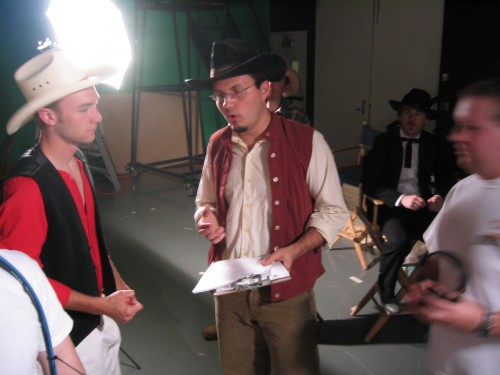
George filled the role as director year after year – it was his job to work with the crew and actors during the production. He was so used to me barking at him about timelines that I’m quite certain he stopped listening to me. He was too focused on ensuring everything was perfect – lights were falling where they should, the actor delivered their line perfectly, the movement in the frame was as it should be, etc. George upholds a quality level that Hollywood should envy and he does not waver from his standards. I have the utmost respect for George and he eye for detail – but we only have 48 hours!!!

Lights, Camera, Action
The 48 hour production time starts on a Friday at 7pm. There is a registration location that we sent a team member to. He pulls our teams genre out of a hat. He is also given a sealed envelope that has the character and prop that we need to work into the film. In a crowded noisy room he makes a phone call to me to pass the information along – this registration location is about 1 1/2 hours away from where we are producing the film. With this information the action now begins.

The Script
We start with a round of brainstorming. What should the story be about? How does the required character fit into the story? Where is the prop going to be used? How critical to the story should these items be? Since it is a competition the more integrated these elements are the better your chances at a prize, but working them in can prove to be a challenge at times. For example, how does DJ Frank Mooney fit into a Western? (You can see how we figured it out by watching Ace of Clubs – 2006.)
With brainstorming done, we let the script writing team go to work. We’ve tried various mixes for the script team from one writer to three writers, even including one that assisted via Skype. The rest of the team is gets kind of bored during this time until the first draft comes out. The writers bring a first draft, we mull it over and make changes where needed. It doesn’t have to be perfect just yet – more or less an outline of the story. This is a crucial point for two reasons – the writers can really go to work making this a well flushed out script now, and the rest of the team can start to organize the rest of the weekend. At this point we know what locations are needed, what costumes should look like, what set pieces and/or props need to be acquired or built, etc. The production crew can start to look at camera angles, determine where lights will be, prep for sound recording, etc. This now starts the “rush rush rush” time!

The Shoot
Over the years we have tried multiple strategies. We did shoots with a LOT of locations (bad idea) and we did some films that only used one studio location and we built a full set. We have done multiple camera crews and only one camera crew. Really the script set the tone for that, but also as time went on we tried to control that as much as possible. Again, we only have 48 hours to produce the film and 4-7 minutes to tell the entire story. Personally, I still am impressed by the entire team on the years that we built in-studio sets. They were rather elaborate and made the scene perfect. We were able to throw them together in hours – I’m still super impressed. To be honest, from what I remember too I told some of the crew we needed a set built and what it should look like. And they ran off. A few hours later I go to see how it’s going and expect them to just be pulling pieces together, yet instead I find that it’s nearly done and being painted. I’m still not sure how it all came together, but it did and it was awesome.

Once the script is complete, approved, and finalized we need to get in front of the camera’s as fast as possible. By this time the actors/actresses have had a chance to figure out wardrobe and props as necessary. The final printing of the script invokes the next surge of go go go!!! We need to get to our shooting locations, setup camera and lighting gear, get organized and get shooting. As with any production, multiple takes per scene and shot are done, and done until the are perfect. Our director wouldn’t have it any other way, which is a good thing. Until we are half way through the shoot in terms of time and only a fourth of the way through the shoot in terms of the script. Yes, it’s happened.

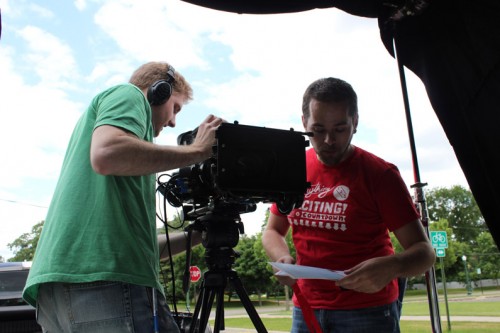
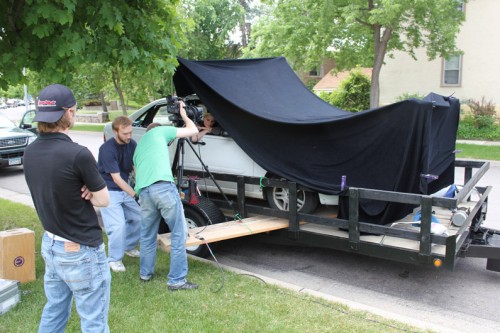
The Edit
The next step is to turn all of the footage shot and turn it into something that looks like a completed film. That means it’s time to wake up our video editor. Or in the case of the years where I produced and edited, it’s time for me to figure out how I’m going to stay up for yet another 20 hours when I’ve been up just as long by this point.
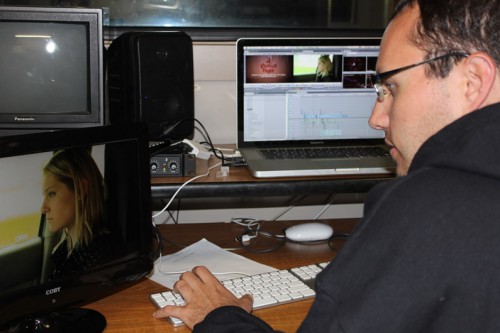
The sooner we get the editor started in the process the better. This allows for extended shooting time, less stress on the editor, and more time to put in some of the finer touches and any special effects or animations that may be required. So as soon as a few scenes have been shot we run the footage back to the editor. This process really worked great. It’s something we sadly didn’t implement in our first year and we can only account that to being a “rookie mistake”.
Review
Once the shoot has been done the director gets a chance to take a break and a much deserved nap. For a few hours only though… This gives the editor time to finish up his work and put the last few scenes/shots into place, apply any final color correction or effects, tweak the timing of shots till they are just right, etc. Once it’s done and polished up, the director and producer and any others that are still awake join the editor to review the film. For most people this is the first time seeing it all come together – their first opportunity to see if the vision and all of the hard work came together as expected. There will typically be some tweaks here and there, change a few shots out to others, maybe adjust the sequence a bit, etc.
If you’ve ever been a perfectionist working on a piece of art, you’ll know that this process could effectively go on forever. Or so it feels at least. But as you’re aware, this weekend is on a deadline. And one other piece to it is that after you call a video complete, there is time needed to do a final render, export the video to a self contained video file, burn it to a DVD and deliver it to judges. So there are several steps and after 10+ years of being a video/film editor I can assure you judging the amount of time needed for this process is very tricky. The render stage is the toughest to gauge. Rendering is the process of the computer piecing together all of the effects and changes you’ve applied to a video into a high resolution output that is ready for displaying on a big screen. The computer will give you an estimated time of how long it will take for this process, but it’s NEVER accurate. I’m pretty sure that over the years of doing this, I’m able to provide a more accurate guess as to how long this will take than the computer does. All that said, the point I’m trying to get across is that we need to set a hard stop time to any tweaks that are made in the review process. Some tweaks are simple and others are more complex and/or will incur longer render times.
Submit The Final Film
Once that review time comes to an end, it’s time to get this film off to the judges as quick as possible. As mentioned above, we still need to go through the process of making this a DVD to deliver to the judges. The drop-off location for this is at the same location as the kickoff where we picked our genre, character, and prop – about 1 1/2 hours away. So NO LATER than 6pm on Sunday night we need to be on the road into the “big city” where traffic can get crazy at times. The drop-off deadline is 7:30 – the provide a 1/2 hour for delivery time.
Now when they say 7:30 is the deadline, they mean it. I kid you not, the first year we did this our film was submitted at 7:31, and thus it was late and disqualified. This time was according to the judges watch. According to our drivers watch, it was 7:29. No sympathy was given to our team or our efforts through the weekend, it was disqualified and we were out of the competition. We made a vow at that moment to NEVER be late on the drop-off again. And we weren’t.
Screening
About 1 week after the productions are done, all of the films are screened on a big screen in a movie theater. Because there are so many films competing, this process takes several days. But this, in my mind, is the best part of the entire 48 Hour Film Project – being able to see your work on a big screen in front of hundreds of people.
The theater is the Riverview Theater in Minneapolis. It’s an older theater that has that perfect nostalgia to it. Quite honestly, I can’t think of a more perfect location to see my work shown. It just has that artsy and historic feel and really brings the whole experience to a close.
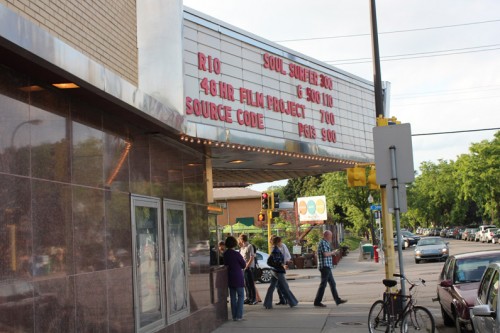
As a team we have made it a point to sit near the back of the theater each year. The seating ramps up nicely so it’s actually a perfect view with great acoustics. But the primary reason for claiming this back row is that during our films screening you have a great view of the entire audience and can see how people react. After-all, the purpose of making a film is to touch the emotions of your audience. If they don’t react to a certain joke or sentiment we built into a scene as we had anticipated they would, then we did something wrong. And as a film maker my goal is to strive to always one-up my previous work. If you aren’t improving then you are just standing still – that’s not how I like to live my life.
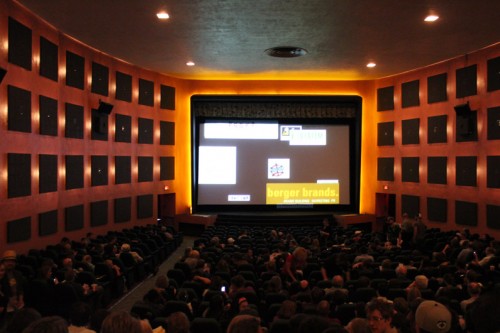
I still find it interesting how much this screening means to me. In my career I have worked on videos that have been made into thousands of DVD’s, broadcast to a viewing population of 50,000+, published videos on YouTube that have received thousands of views, yet I get SOOO excited about my film being screened in a theater of a few hundred. I’ve tried to analyze why I have such a different emotional connection and have realized it is quite simple really – in the aforementioned distribution channels, I’m not there to see the audience see my work. But in the theater I’m part of the viewing process and can accept their gratitude for my work via hearing them laugh or sigh or groan as expected. They don’t know who I am during my film, but yet they are all patting me on the back without knowing it. And that is a feeling that I’ll never receive when someone watches a DVD in their house without me knowing.
Watch The Films
Reading about films isn’t nearly as exciting as watching them, that’s for sure! All of the films I have produced for the 48 Hour Film Project are on a website at the link below, as well as a few other films that were created for other similar film competitions.
So without further ado, grab your self a bowl of popcorn and enjoy the films!
